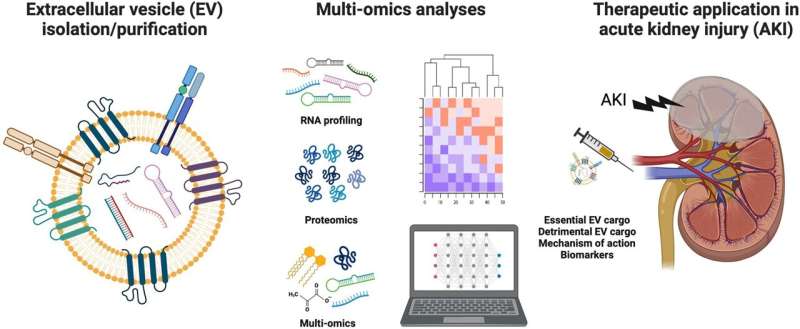Extracellular vesicles could be potential new treatment for acute kidney injury
- Get link
- X
- Other Apps

Acute kidney injury has many different causes that can result in a high death rate if not properly treated. There are currently limited therapeutic strategies available to manage acute kidney injury. However, a new joint study by Cardiff University School of Medicine and TaiPei Medical University revealed «major experimental evidence» regarding the therapeutic potential of extracellular vesicles in acute kidney injury.
The study, «Systems approaches to cell culture-derived extracellular vesicles for acute kidney injury therapy: prospects and challenges,» was published in the journal Function.
Extracellular vesicles are membrane-bound vesicles secreted by various cell types that can serve as cell-free therapy through transferring bioactive (an effect on living organisms) molecules. However, this study’s authors conceded insufficient understanding of extracellular vesicles, and more research is needed.
There is currently a lack of standardization or agreed-upon best practices for acute kidney injury, and most research articles use varying extracellular vesicles isolation methods, doses, timings and administration routes, many of which are not easily translated to humans.
«Cell-derived [extracellular vesicles] clearly have great potential in [acute kidney injury] therapy and their activity has been consistently demonstrated in multiple animal models,» the research team wrote.
«Given their natural role as dynamic mediators of paracrine effects and cargo of biologically active substances, there is also strong biological plausibility for their therapeutic use.»
More information:
David J Lundy et al, Systems Approaches to Cell Culture-Derived Extracellular Vesicles for Acute Kidney Injury Therapy: Prospects and Challenges, Function (2024). DOI: 10.1093/function/zqae012
Provided by
American Physiological Society
Citation:
Extracellular vesicles could be potential new treatment for acute kidney injury (2024, June 7)
retrieved 16 June 2024
from
This document is subject to copyright. Apart from any fair dealing for the purpose of private study or research, no
part may be reproduced without the written permission. The content is provided for information purposes only.
- Get link
- X
- Other Apps
Comments
Post a Comment